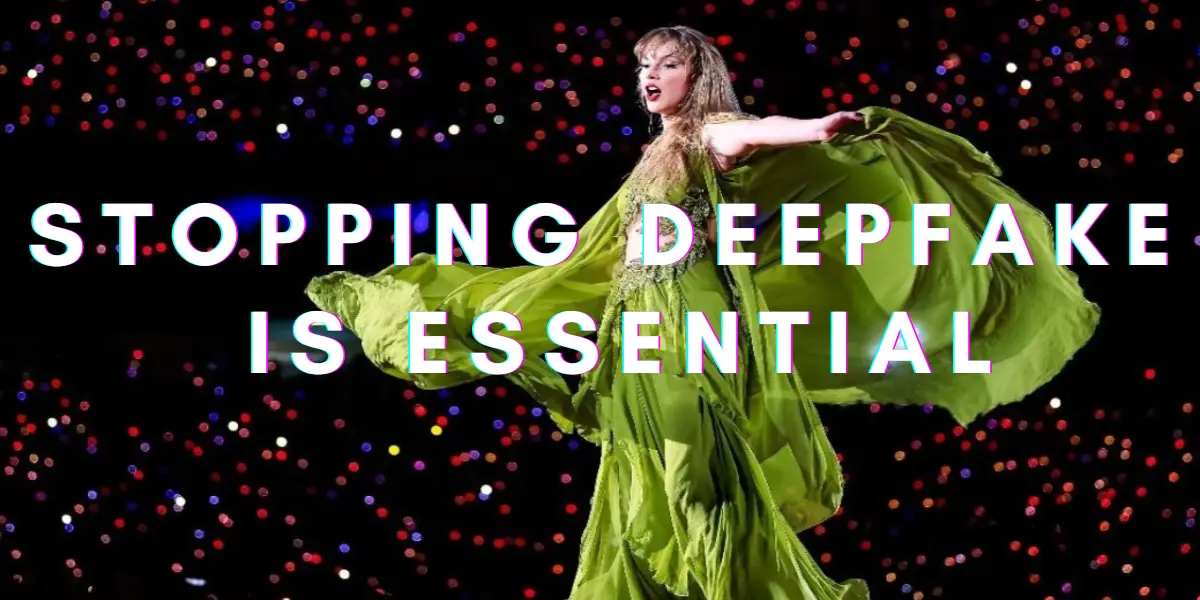Stopping Deepfake is Essential: Taylor Swift's Recent Ordeal Underscores the Urgency

In the digital age, the proliferation of AI tools has brought about revolutionary changes in various fields, including entertainment, media, and personal privacy. However, this technological advancement has also paved the way for new forms of digital abuse, most notably through the creation of deepfakes. These AI image generators and AI video generators, which can convincingly replicate the likeness of individuals, have raised significant ethical and legal concerns. The recent controversy surrounding nonconsensual AI-generated images of Taylor Swift and other celebrities has highlighted the urgent need for a balanced approach to AI development, one that ensures innovation while protecting individual rights and maintaining ethical standards.
The controversy surrounding AI-generated images of Taylor Swift and other celebrities has cast a spotlight on the darker aspects of AI advancements, revealing a pressing need for ethical guidelines and legal protections.
Table of Contents
AI-Generated Nude Photos of Swift Go Viral
In a disturbing turn of events, the digital realm was recently shaken by the widespread dissemination of AI-generated n*de photos of Taylor Swift. This incident not only crossed the boundaries of privacy and consent but also showcased the dark potential of artificial intelligence when wielded irresponsibly. The images, alarmingly realistic, were crafted using advanced AI tools capable of generating highly convincing and detailed visuals. Despite the existence of policies against such misuse, like those enforced by Microsoft for its Designer tool, certain individuals exploited the technology to create and distribute these images without Swift’s consent.
The viral spread of these photos was unprecedented, with one post on the social media platform X amassing over 45 million views before it was ultimately removed. This rapid dissemination highlights the viral nature of digital content, especially when it involves celebrities, and the challenges in controlling the spread of such material once it’s out in the wild. The AI-generated images served not just as a violation of Swift’s privacy but also as a stark reminder of the potential for harm that these technologies possess. They underscore the urgent need for a balanced approach to AI development and usage, one that prioritizes ethical considerations and the protection of individual rights.

What is NSFW Taylor Swift AI Pics?
NSFW (Not Safe For Work) Taylor Swift AI pics refer to explicit images of the pop icon that were generated using artificial intelligence without her permission. This unethical use of AI technology represents a clear violation of privacy and raises significant ethical and legal questions. The creation and distribution of such content not only harm the individuals depicted but also contribute to a broader culture of disrespect and objectification, particularly targeting public figures and women. This incident serves as a critical reminder of the darker applications of AI and the need for stringent safeguards and ethical standards in its deployment.
What is Deepfake?
Deepfake technology refers to the use of artificial intelligence to create or alter video and audio recordings, making them appear genuine, even though they are not. This is achieved by training AI algorithms on a vast dataset of real images and videos to learn and replicate the appearance, movements, and sounds of individuals. Deepfakes are often so convincing that they can be difficult to distinguish from real footage, leading to potential misuse in creating false narratives, impersonating individuals, and spreading misinformation. While deepfakes have legitimate applications in entertainment and education, their capacity for deception raises significant ethical and legal concerns, particularly regarding consent, privacy, and the spread of fake news.
Risks posed by deepfakes
Deepfakes pose significant risks to individuals and society by blurring the line between reality and fabrication.
- Privacy Violations: Deepfakes can be used to create convincing but false images or videos of individuals without their consent, infringing on their privacy.
- Misinformation and Disinformation: They can spread false information, manipulating public opinion and potentially influencing political elections and other important societal decisions.
- Reputation Damage: Individuals can be falsely depicted in compromising or harmful situations, leading to personal and professional reputation damage.
- Cyberbullying and Harassment: Deepfakes can be weaponized for personal attacks, cyberbullying, and harassment, causing emotional and psychological harm to victims.
- Security Threats: They can be used to impersonate public figures or officials, creating fake endorsements, false alarms, or fraudulent instructions that could lead to widespread panic or security breaches.
- Erosion of Trust: The prevalence of deepfakes can erode trust in media, institutions, and public figures, as distinguishing between real and fake content becomes increasingly difficult.
- Legal and Ethical Challenges: Deepfakes raise complex legal and ethical issues, including the challenge of regulating their creation and distribution without infringing on freedom of expression.

Swift's Global Fanbase, Known as “Swifties,” Fights Back
Swifties Mobilize on Social Media
Swift’s global fanbase, known as “Swifties,” has taken a proactive stance against the misuse of her image in deepfakes. Leveraging the power of social media, they have created a formidable network to support Swift, using hashtags and online campaigns to raise awareness and combat the spread of these harmful images. Their collective action demonstrates the strength of community and the role of fans in protecting their beloved artist’s image and reputation.
Legal Advocacy and Public Awareness
Swifties have extended their efforts beyond social media, engaging in legal advocacy and public awareness campaigns. They have called for stronger laws against digital abuse and deepfakes, highlighting the need for legal reforms to protect individuals’ rights in the digital age. Their activism underscores the importance of legal recourse in addressing new technological challenges and the power of a united fanbase in initiating change.
Educational Outreach and Support
Understanding the broader implications of deepfakes, Swifties have also engaged in educational outreach, informing the public about the dangers of deepfake technology and how it can be misused. They have created resources and forums to educate others, fostering a more informed and conscientious online community. This educational approach not only aids in the fight against deepfakes but also empowers individuals with knowledge to protect themselves and others from digital exploitation.
Are Taylor Swift AI porn images illegal?
The legality of AI-generated explicit images, such as those of Taylor Swift, varies by jurisdiction and is a complex issue. While some regions have laws against the creation and distribution of nonconsensual explicit content, including deepfakes, many places lack specific legislation addressing AI-generated images. This legal gray area complicates efforts to combat such content and hold perpetrators accountable. As a result, the creation and distribution of these images often fall into a murky legal territory, highlighting the urgent need for updated laws that specifically address the challenges posed by AI and deepfake technologies.
Other Celebrities Face Similar Attacks
1.Scarlett Johansson: Battling Unauthorized Digital Likeness

Scarlett Johansson’s encounter with deepfake technology, where her image was manipulated into explicit content, underscores the invasive nature of this technology.
- Widespread Misuse: Her likeness has been widely misused in deepfake pornography, affecting her personal dignity.
- Legal Hurdles: Johansson faces significant legal obstacles in addressing these violations, given the anonymity of online perpetrators.
- Call for Action: Her case has led to calls for more stringent laws and regulations against deepfake content.
2.Emma Watson: An Advocate's Image Compromised

Emma Watson, known for her advocacy in women’s rights, has seen her image tarnished by deepfakes, creating a stark contrast to her real-life persona. This misuse not only invades her privacy but also seeks to undermine her advocacy efforts.
- Contradiction to Advocacy: Deepfakes featuring Watson contradict her public stance on women’s rights and privacy.
- Impact on Public Image: The creation of explicit deepfakes damages her reputation and the causes she champions.
- Need for Digital Rights: Watson’s experience highlights the importance of protecting individuals’ digital rights and integrity.
3.Keanu Reeves: From Memes to Malicious Use

Keanu Reeves’ laid-back and beloved public image has made him a frequent subject of deepfakes, ranging from humorous memes to more concerning manipulations that blur ethical lines.
- Diverse Misuse: Reeves’ image has been used in both light-hearted and harmful deepfake content.
- Public Perception: The manipulation of his likable persona demonstrates how deepfakes can twist public perception.
- Ethical Concerns: The varying uses of Reeves’ deepfakes raise questions about the ethical implications of digital impersonation.
Nonconsensual Deepfakes Disproportionately Target Women
Highlighting Gendered Exploitation
Nonconsensual deepfakes disproportionately affect women, often targeting them for sexual exploitation and harassment. This gendered aspect of deepfakes reflects broader societal issues of objectification and gender-based violence. Women, especially those in the public eye, are more likely to be victims of these invasive technologies, which are used to degrade and humiliate them. This trend underscores the need for a gender-sensitive approach in addressing and combating deepfake technology.
Amplifying Voices for Legal Reform
The prevalence of nonconsensual deepfakes targeting women has catalyzed a movement for legal reform. Advocates and victims are calling for laws that specifically address the creation and distribution of deepfake content, with a focus on protecting women’s rights and dignity. This push for legal change is crucial in establishing clear consequences for those who misuse AI to harm women, aiming to deter such behavior and provide recourse for victims.
Empowering Through Education and Awareness
Education and awareness are key in the fight against nonconsensual deepfakes targeting women. Initiatives aimed at educating the public about the realities and risks of deepfake technology, particularly its impact on women, are essential. By raising awareness, these efforts empower individuals to recognize and stand against the misuse of deepfakes, fostering a more informed and supportive community that upholds the rights and dignity of women.
Conclusion
The emergence of deepfake technology and its misuse, particularly in the creation of nonconsensual AI-generated images of public figures like Taylor Swift, underscores a critical juncture in our digital evolution. It highlights the darker side of AI advancements, where the line between reality and fabrication becomes increasingly blurred, leading to significant privacy violations, reputational damage, and ethical dilemmas. The global response, especially from dedicated fanbases like Swifties, alongside calls for legal reform and increased public awareness, reflects a collective effort to navigate these challenges. As we move forward, it’s imperative that technological innovation is matched with ethical considerations and robust legal frameworks to safeguard individual dignity and societal values.

